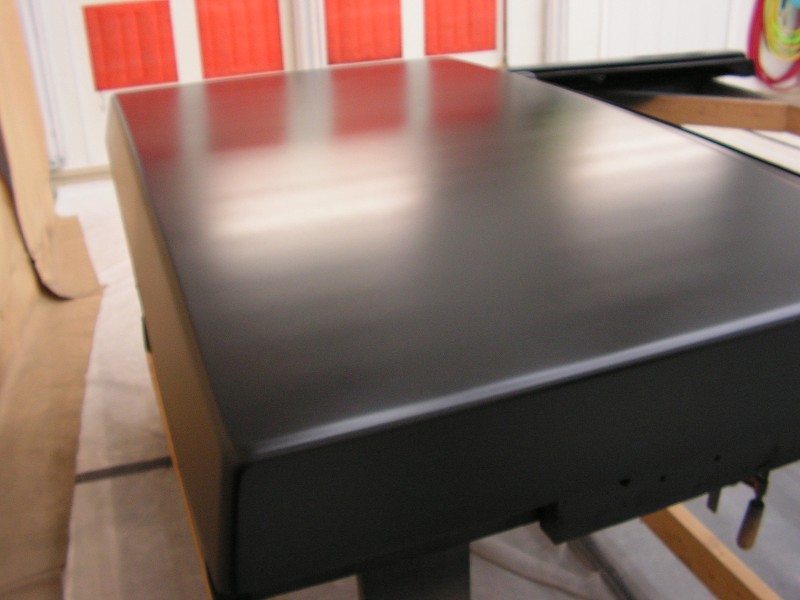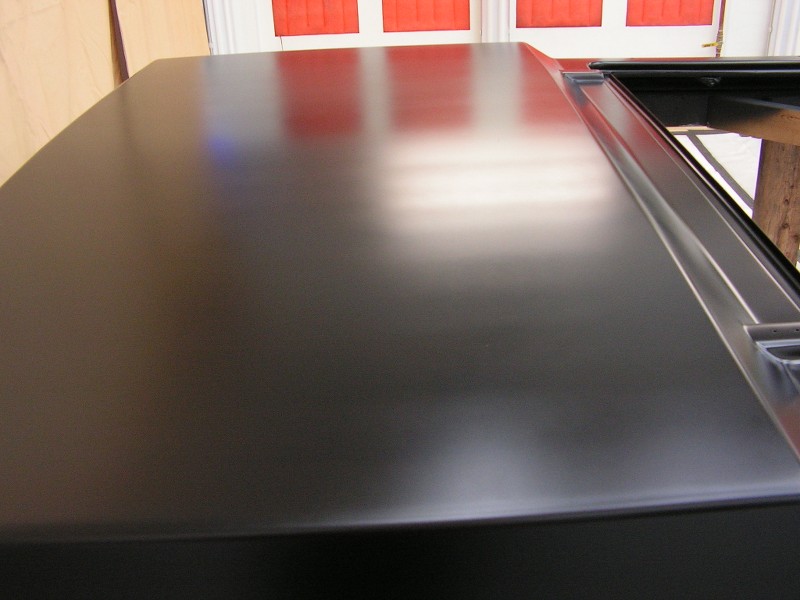rustover
Member
Sometime when I spray it, it turns out nice and other times, not so good. The other night I sprayed the lid and cover that I'm working on with 2 coats of epoxy.
The lid was shot with full strength epoxy that had been induced for about 3 hours and sprayed with a 1.8 tip for build to block with 320 grit. Overall the lid turned out nice. Not as smooth, some slight peel, but I used a 1.8 tip.
The cover shot with epoxy reduced 20% induced for three hours. Temp of the garage and surface temps was 74 degrees. My lph400 silver cap settings were 23psi, fan maxed out and just turned back in slightly and fluid was 2.25 turns out. I was about 4-5 inches from the panel and speed seems slow to me. Just fast enough to keep up with the wet edge. The last few times I have shot it, I striped it really good. I have been video my spraying and when I watch it back I would like to jump and there and grab the gun out of my hand.
There are times when I don't have the air cap parallel to the surface. Instead of being at 6 o'clock I'm more at 6:35. If that makes sense. I believe this is where a lot of my problem is, but there has been times in other vids that I sprayed it like this and it did fine. The middle of the cover is a reach and something I need to work on is locking my wrist when I get fully extended. Not only do I stripe it in the middle I also striped it where there is no reach near the edges so this leads me to believe it may be something else.
The other thing I noticed is I was a little too wet, especially on the first coat. I know the cover was cleaned well. I used both 700/710, about an hour apart and let the cover sit until the next evening prior to spraying. There was a few places that when the epoxy hit the surface it acted a little funny, kinda gave a swiss cheese look. Those areas didn't look to bad after it flashed. I believe I should have turned the fluid in .25 turns or more.
The one thing that has me puzzled and may be contributing to the striping is my overlap. I have been using about a 70 percent overlap. There are times when I spraying doing this overlap and watching the edge and it looks like I missed an area that I just passed. I don't understand how that can happen with the fan on the lph400. I measured my test fan and it was 9 inches. So when I moved up say 3 inches and make a pass there is an area left behind that looks like I missed. (It could be that the paint just hasn't melted in yet) I don't know.
I know I need to work on my technique. I'm really close, but that still doesn't make it look good. What do you guys think, especially on the overlap. I was frustrated the other night. Thanks for the help. Russ


The lid was shot with full strength epoxy that had been induced for about 3 hours and sprayed with a 1.8 tip for build to block with 320 grit. Overall the lid turned out nice. Not as smooth, some slight peel, but I used a 1.8 tip.
The cover shot with epoxy reduced 20% induced for three hours. Temp of the garage and surface temps was 74 degrees. My lph400 silver cap settings were 23psi, fan maxed out and just turned back in slightly and fluid was 2.25 turns out. I was about 4-5 inches from the panel and speed seems slow to me. Just fast enough to keep up with the wet edge. The last few times I have shot it, I striped it really good. I have been video my spraying and when I watch it back I would like to jump and there and grab the gun out of my hand.
There are times when I don't have the air cap parallel to the surface. Instead of being at 6 o'clock I'm more at 6:35. If that makes sense. I believe this is where a lot of my problem is, but there has been times in other vids that I sprayed it like this and it did fine. The middle of the cover is a reach and something I need to work on is locking my wrist when I get fully extended. Not only do I stripe it in the middle I also striped it where there is no reach near the edges so this leads me to believe it may be something else.
The other thing I noticed is I was a little too wet, especially on the first coat. I know the cover was cleaned well. I used both 700/710, about an hour apart and let the cover sit until the next evening prior to spraying. There was a few places that when the epoxy hit the surface it acted a little funny, kinda gave a swiss cheese look. Those areas didn't look to bad after it flashed. I believe I should have turned the fluid in .25 turns or more.
The one thing that has me puzzled and may be contributing to the striping is my overlap. I have been using about a 70 percent overlap. There are times when I spraying doing this overlap and watching the edge and it looks like I missed an area that I just passed. I don't understand how that can happen with the fan on the lph400. I measured my test fan and it was 9 inches. So when I moved up say 3 inches and make a pass there is an area left behind that looks like I missed. (It could be that the paint just hasn't melted in yet) I don't know.
I know I need to work on my technique. I'm really close, but that still doesn't make it look good. What do you guys think, especially on the overlap. I was frustrated the other night. Thanks for the help. Russ


